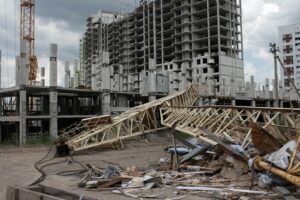Expo 2020 Dubai was the world’s showcase for sustainability, safety and security, enabled by data-driven infrastructure that was supported in part by EarthSense Zephyr air quality sensors, providing a global benchmark for future smart cities.
Despite its name, Covid saw to it that Expo 2020 actually began at the end of 2021 and ended in 2022.
With more than 24 million visitors over 182 days, it was the definition of a mega-event, with its international profile and potential to reposition the city on the global stage. Such mega-events naturally have an impact on the host locality and event organisers are driven to maximise the positive sustainability and legacy potential while minimising any possible negative effects. A mega-event inevitably affects air quality as a key element of overall health and safety of attendees, volunteers and other participants.
Research that collected data at various locations in Dubai, with some as close as under 6 miles away (9.44km) from the Expo 2020 Dubai site, highlights some of the air quality challenges in Dubai.
The studies indicate that indoor air quality is directly affected by outdoor air quality. And Dubai’s weather conditions, with temperatures often exceeding 40°C and limited rainfall also contribute to poor air quality increasing levels of PM2.5 and PM10.
Local EarthSense distribution partner, AQM World, installed an air quality monitoring network powered by Zephyr sensors integrated with the Siemens industrial Internet of Things (IoT) system, MindSphere platform to ensure continuous monitoring for health and safety.
AQM World installed EarthSense Zephyr units throughout the Expo 2020 site in the three primary districts of Sustainability, Opportunity, and Mobility. The company deployed 10 Zephyr units indoors and in underground spaces, and two further units in ambient, park and plaza settings to measure indoor and ambient air quality concentrations.
The Zephyr units took live readings of temperature, pressure, and humidity as well as ambient air pollutants including nitric oxide (NO), nitrogen dioxide (NO2), ozone (O3), hydrogen sulphide (H2S), sulphur dioxide (SO2), total volatile organic compounds (TVOC) and particulate matter (PM1, PM2.5 and PM10). All of this data was then integrated via the EarthSense API into the Siemens MindSphere platform.
EarthSense and AQM compared measurements from the Expo site with those from other monitoring stations in Dubai, to assess the characteristics of air pollution at the Expo site. They also compared concentrations throughout indoor spaces with ambient locations, to understand the interplay between indoor and outdoor air on site.
The Zephyr measurements enabled the Siemens MindSphere platform to trigger alerts when air quality concentrations reached pre-established thresholds, helping to manage participant and attendee air pollution exposure. Authorised personnel could use the Expo 2020 smart city app for a range of detailed environmental data, including air quality and weather conditions, as well as electric vehicle charging, building occupancy, waste volume, and a range of other smart city data.
In 2020, the UAE reported 89% of ‘Green Days’ (AQI NO2, SO2, CO, ground level O3) where certain pollutants did not exceed their standards. This was an increase of 8% from 2019 and 18% from 2017. For PM10 83.9% in 2020, an improvement of 2.9% from 2019 and 12.9% from 2018. For PM2.5, 93.2% green days in 2020, a 5.2% improvement on 2019 and a 13.2% improvement on 2018 .
While the specific impact of Expo 2020 on air quality in Dubai is yet to be examined, academic studies from Expo 2010 Shanghai indicate that air quality measures were effective in Shanghai and surrounding provinces during the Expo period where pollution levels decreased during the event (Huang et al., 2013) . It demonstrated that stringent emission control measures aimed at mega-events can achieve positive benefits on improving the air quality.
Expo 2020 Dubai was designed to be the most sustainable world Expo in history. The strategy of Respect, Impact, Safety, and Environment (RISE) was created to integrate a number of processes and methodologies across every aspect of operations to demonstrate how businesses, cities and even countries can transition into a green economy.
At least 80% of Expo 2020’s permanent infrastructure is being repurposed as a model global community for the future, District 2020, which will use state-of-the-art innovation, science, and sustainability to create a human-centric smart city.
Research into managing the sustainability of global events suggests “mega-events should act as a catalyst for behavioural change”. A study of environmental awareness of 1,108 Expo attendees was measured before and after the Expo. Results show that visiting the Expo has raised the environmental awareness of visitors and the Expo’s visits increased environmental attitude.
Behaviour change combined with policy development pathways to reduce urban air pollution and emissions of air pollutants and greenhouse gases can help to continually improve air quality in Dubai after Expo 2020.

















Leave a Reply